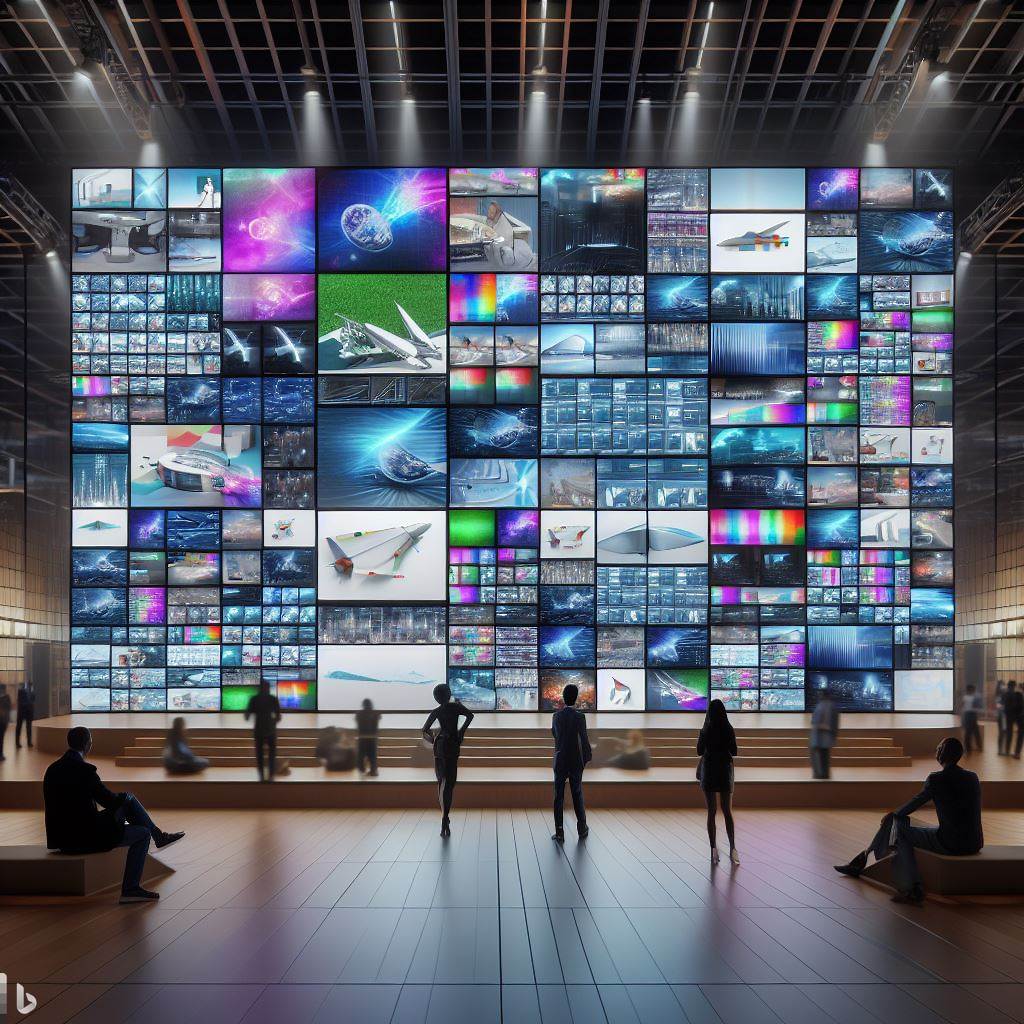What is a video wall
Definition of a Video Wall
Video walls are a powerful and cutting-edge display solution that have revolutionized the way businesses communicate and engage with their audience. Simply put, a video wall is a large display arrangement made up of multiple screens, seamlessly tiled together to create one cohesive and impressive display. It is a versatile technology that can be used in a wide range of applications, including command centers, control rooms, retail environments, public spaces, and more. With their high resolution, vibrant colors, and narrow bezels, video walls offer a stunning visual experience that captivates and grabs attention. Whether used for advertising, wayfinding, information display, or entertainment purposes, video walls have the ability to deliver impactful and immersive content that leaves a lasting impression on viewers. They can be customized to fit any size or shape, offering maximum flexibility to create unique and dynamic display configurations. Additionally, video walls can be controlled easily and efficiently, allowing users to display and manage different content sources simultaneously. Overall, video walls provide a powerful and effective digital signage solution that enhances customer and user experiences in various settings.
Overview of the Different Components
A video wall is a large display system made up of multiple individual displays that work together to create a single cohesive image or video. These displays, also known as screens, are the primary hardware component of a video wall. They can be LCD panels or LED panels, depending on the desired image quality and specific requirements. LCD panels are commonly used for indoor settings, while LED panels are preferred for outdoor advertising due to their better visibility under bright ambient light.
A video wall controller is another essential component of a video wall system. This hardware device connects to all the individual displays and manages the distribution of content across them. It ensures that the content is seamlessly displayed on the correct screen, controlling factors such as resolution, pixel density, and screen synchronization. The video wall controller also allows for easy management of input sources and enables the display of multiple sources simultaneously.
To effectively manage the content displayed on the video wall, content management software is necessary. This software allows users to control and schedule the content, adjust the display layout, and monitor the performance of the video wall in real-time. It provides a user-friendly interface to create captivating visuals and deliver a targeted message to the audience.
In summary, a video wall is composed of displays, video wall controllers, and content management software. These components work together to create a stunning visual experience by seamlessly distributing and managing content across multiple screens.
Types of Video Walls
Video walls are powerful tools for creating impactful visual displays in various settings, from command centers and shopping malls to public spaces and corporate offices. There are different types of video walls available, each offering unique features and benefits to suit specific requirements. One type is the LCD video wall, which utilizes individual LCD panels tiled together to create a large, high-resolution display. LCD video walls are known for their excellent image quality and thin bezels, resulting in a seamless and immersive viewing experience. Another type is the LED video wall, which consists of individual LED panels that can be easily combined to form a large-scale display. LED video walls offer high brightness levels and pixel density, making them ideal for outdoor advertising and areas with high ambient light. Moreover, there are also hybrid video walls that combine both LCD and LED technologies, providing flexibility in terms of installation and customization options. With the right type of video wall, businesses can effectively engage their audiences and deliver captivating visual experiences.
LCD Video Walls
LCD video walls are a popular display technology used in various industries and public spaces. These video walls are composed of multiple LCD panels seamlessly joined together to create a large and impressive display surface.
One of the key characteristics of LCD video walls is their sleek and slim profile. The panels used in these video walls have narrow bezels, resulting in a seamless and uninterrupted viewing experience. This makes LCD video walls perfect for applications where a large, continuous display is required.
LCD video walls also offer excellent image quality, with vibrant colors and sharp details. The individual LCD panels can be calibrated to ensure uniformity in brightness and color across the entire wall, providing an immersive and consistent viewing experience.
One of the advantages of LCD video walls is their flexibility. The number of panels used can be easily adjusted to suit the desired size and configuration of the video wall. This allows for customization and scalability, making LCD video walls suitable for a variety of environments.
In addition, LCD video walls are easy to install and maintain. The panels can be mounted on a wall or placed on freestanding structures, and their modular design allows for easy access and replacement of individual panels if needed.
Overall, LCD video walls offer a versatile and high-quality display solution for a wide range of applications, including command centers, digital signage, control rooms, and public spaces. Their seamless design, excellent image quality, and flexibility make them a preferred choice for businesses looking to create impactful visual experiences.
LED Video Walls
LED video walls are a cutting-edge display technology that offers a host of features and benefits. By utilizing LED technology, these video walls create stunning displays that can captivate audiences in a wide range of settings.
One of the key features of LED video walls is their superior brightness. LED panels are known for their high luminosity, allowing for clear and vivid visuals even in well-lit environments. This makes LED video walls ideal for outdoor advertising, command centers, and public spaces where ambient light can be a challenge.
Another advantage of LED video walls is their exceptional contrast. The LED technology used in these panels allows for deep blacks and vibrant colors, resulting in striking visuals that leave a lasting impression. This makes LED video walls perfect for digital signage solutions, shopping malls, and professional displays.
LED panels also offer energy efficiency, consuming less power compared to traditional display technologies. This not only reduces operating costs but also contributes to a more environmentally friendly solution.
Overall, LED video walls provide a dynamic and engaging viewing experience. With their key features such as superior brightness, contrast, and energy efficiency, they enable businesses to create stunning displays that capture attention and enhance the customer experience.
Single Image Video Walls
Single image video walls are innovative display solutions that consist of multiple individual displays seamlessly combined together to create a large, continuous image or video. This technology allows for a visually immersive experience and is commonly used in command centers, control rooms, and public spaces where a larger viewing area is required.
The main feature of single image video walls is their ability to create a seamless and uninterrupted image or video. By aligning the edges of each individual display and using advanced video wall processors and software, these video walls can eliminate any visible gaps or bezels to create a smooth and cohesive visual display.
Command centers and control rooms can benefit greatly from single image video walls as they provide a panoramic view of critical information and data. Operators can monitor multiple feeds simultaneously, enhancing situational awareness and decision-making capabilities.
In public spaces, single image video walls can captivate audiences with their size and immersive nature. They are used for digital signage, advertising displays, and information dissemination, providing an engaging and informative experience.
Overall, single image video walls offer a practical and visually stunning solution for creating large-scale displays in command centers, control rooms, and public spaces.
Multiple Image Video Walls
Multiple image video walls are a powerful display solution that utilizes multiple screens to simultaneously display separate images. Unlike single image video walls, which create a cohesive visual display, multiple image video walls enable the display of different content on each screen, expanding the possibilities for information dissemination and engagement.
These video walls are commonly used in various applications, including digital signage, command centers, and entertainment venues. In command centers and control rooms, multiple image video walls allow operators to monitor and analyze multiple data feeds simultaneously. This enhances situational awareness and decision-making capabilities, as relevant information can be displayed on each screen.
In entertainment venues and public spaces, multiple image video walls can create a dynamic and engaging visual experience. Different images, videos, or advertisements can be displayed on each screen, catering to different audiences or conveying multiple messages at the same time. This versatility allows for more targeted and impactful communication.
Another benefit of multiple image video walls is the ability to create a larger composite image by extending content across multiple screens. This can be particularly useful for showcasing panoramic views, intricate visuals, or high-resolution content that requires a larger display area.
Overall, multiple image video walls are a flexible and impactful solution that enables the simultaneous display of separate images, enhancing communication and creating visually stunning experiences.
Benefits of a Video Wall
Video walls offer numerous benefits in various applications and industries. These large display solutions are widely used in digital signage, command centers, and entertainment venues, among others. One key benefit is the ability to enhance situational awareness and decision-making capabilities in command centers and control rooms. Operators can monitor and analyze multiple data feeds simultaneously, thanks to the multiple image video walls. This allows for relevant information to be displayed on each screen, enabling operators to make informed decisions quickly. In entertainment venues and public spaces, video walls create a dynamic and engaging visual experience. Different images, videos, or advertisements can be displayed on each screen, catering to diverse audiences and conveying multiple messages simultaneously. The versatility of video walls also allows for the creation of a larger composite image by extending content across multiple screens. This is particularly useful for showcasing panoramic views, intricate visuals, or high-resolution content that requires a larger display area. Overall, video walls offer a powerful and impactful means of communication, making them a valuable asset in various settings.
Improved Image Quality
Video walls are known for their ability to deliver an astonishing level of image quality, making them a go-to choice for digital signage and advertising purposes. These walls utilize advanced video wall technology to provide unparalleled visual performance.
One of the key features of video walls is their high resolution. With cutting-edge LED panels, video walls offer exceptional pixel density, resulting in sharp images and vibrant colors. This high resolution allows for intricate details to be displayed with clarity, creating a captivating viewing experience.
The use of video wall technology ensures pixel-perfect displays. Each individual pixel on the video wall is precisely controlled to reproduce the content accurately, eliminating any distortion or blurriness that may be present in other display technologies. This attention to detail guarantees that images are presented with the utmost accuracy and sharpness.
The improved image quality of video walls elevates the overall visual experience, making them ideal for a variety of applications in public spaces, command centers, shopping malls, and even Times Square. Whether it’s showcasing advertisements, conveying information, or enhancing customer experience, video walls deliver stunning image quality that captures the attention of viewers.
Versatility and Flexibility
Video walls offer unmatched versatility and flexibility in displaying content, making them an ideal choice for a wide range of environments and applications. One of the key advantages is their customizable nature, allowing them to be adapted to fit various specifications and requirements.
A video wall can be configured to display multiple sources simultaneously, offering the ability to showcase different content side by side. This is particularly useful in command centers or control rooms where monitoring multiple feeds from different sources is necessary.
Additionally, video walls can also be configured to create a single, large-scale image by combining multiple screens seamlessly. This is perfect for creating impactful visual displays in public spaces or for large-scale presentations.
The customizable and adaptable nature of video walls makes them a versatile solution for various industries such as retail, hospitality, education, and entertainment. Whether it’s for advertising, communication, or entertainment purposes, video walls provide endless possibilities for delivering captivating content.
Cost-Effectiveness and Durability
Video walls offer a cost-effective and durable solution for displaying content in various settings. One of the key advantages of video walls is their long lifespan, which contributes to their overall cost-effectiveness. With proper maintenance and care, video walls can last for many years, making them a wise investment for businesses and organizations.
Moreover, video walls require low maintenance, reducing the need for frequent repairs or replacements. This further contributes to their cost-effectiveness by minimizing downtime and associated costs. Additionally, video walls are energy-efficient, consuming less power compared to multiple individual displays. This not only translates to lower operating costs but also helps in reducing the carbon footprint.
Another aspect that adds to the cost-effectiveness of video walls is the elimination of multiple individual displays. By consolidating multiple screens into one large display, businesses can reduce hardware and installation costs significantly. This is particularly beneficial in large-scale projects or environments where multiple displays would be required.
In terms of durability, video walls excel in various environments, including public spaces and outdoor advertising. They are built to withstand the rigors of constant use, ensuring uninterrupted performance and longevity. With features such as rugged enclosures and protective coatings, video walls can endure harsh weather conditions and withstand accidental impacts.
Overall, video walls provide a cost-effective solution that combines durability, long lifespan, low maintenance requirements, and energy efficiency. Their ability to consolidate multiple displays and withstand various environments make them a reliable choice for businesses looking for impactful and long-lasting visual displays.
Increased Visibility and Impact
Video walls are a powerful tool for capturing attention, engaging viewers, and creating a memorable visual experience. With their large size and bright, high-resolution displays, video walls are highly effective in grabbing the audience’s attention in public spaces like shopping malls or command centers.
The increased visibility of video walls ensures that businesses can showcase their content, advertisements, or messages to a wide audience. The captivating nature of video walls makes it hard for onlookers to ignore the display, drawing them in and creating an engaging experience. Whether it’s a vibrant digital signage solution or an eye-catching video display, video walls have the ability to leave a lasting impact on viewers.
Furthermore, the size and resolution of video walls allow for stunning visuals that can leave a memorable impression. The crisp, clear image quality and seamless content delivery make it easier for businesses to communicate their message effectively. Whether it’s displaying a single image across the entire wall or showcasing multiple dynamic images, video walls provide a visually stunning experience that is hard to forget.
In conclusion, video walls offer increased visibility and impact by grabbing attention, engaging viewers, and creating a memorable visual experience. Their size, brightness, and high-resolution displays make them the perfect solution for businesses looking to make a lasting impression in public spaces or command centers. With their ability to captivate audiences and communicate messages effectively, video walls are a valuable tool for creating an impactful and memorable customer experience.
Factors to Consider When Choosing a Video Wall
When considering a video wall for your business or organization, there are several important factors to take into account to ensure you make the best choice for your needs. Firstly, one must consider the type of video wall technology that will be most suitable. LED video walls offer high brightness and vibrant colors, making them ideal for outdoor advertising or locations with high ambient light. On the other hand, LCD video walls offer superior image quality and are often preferred for indoor use or applications that require fine details. Another factor to consider is the screen size and the number of individual screens required to create the video wall. Additionally, the size of the display is important as it needs to be appropriately scaled for the space it will occupy. Narrow bezels and thinner mullions between screens can provide a more seamless visual experience. The pixel pitch and pixel density also play a role in the image quality and resolution of the video wall. It’s essential to choose a pixel resolution that suits your content and ensures clear and sharp visuals. Furthermore, it’s crucial to consider the video wall controller and software. A reliable video wall controller will allow you to manage and control the content displayed, while the right software can provide the necessary tools for content management and scheduling. Lastly, professional services, such as installation and support, should be taken into account, as well as the operating costs associated with the video wall. By considering these factors, you can ensure that you choose the right video wall solution that meets your specific requirements and delivers an exceptional visual experience.
Screen Size, Resolution & Pixel Density
When choosing a video wall, screen size, resolution, and pixel density are crucial factors to consider.
Screen size plays a vital role in the overall visual impact of the video wall. Larger screens attract more attention and create a more immersive experience in public spaces such as shopping malls or command centers.
Resolution determines the clarity of the displayed content. Higher resolution guarantees sharper and more detailed images or videos on the video wall.
Pixel density is another important consideration. It refers to the number of pixels per inch on the display. Higher pixel density translates to a crisper image and a more realistic viewing experience.
Pixel pitch is directly related to pixel density. It denotes the distance between individual pixels. Smaller pixel pitch results in a higher pixel density and improved image quality.
To ensure an optimal viewing experience, it is crucial to consider the recommended viewing distance for the desired screen size. Striking a balance between screen size, resolution, and pixel density is essential for delivering impactful content on a video wall.
Type of Display Technology Used (LCD or LED)
Video walls can be constructed using different types of display technology, with LCD (Liquid Crystal Display) and LED (Light Emitting Diode) being the most commonly used options.
LCD video walls utilize LCD panels to display images and videos. They offer excellent image quality with high resolution and color accuracy. LCD panels have a longer lifespan compared to LED panels, making them a durable choice for video wall applications. However, LCD video walls tend to have lower brightness levels, which may make them less suitable for environments with high ambient light.
On the other hand, LED video walls use LED panels to create vibrant and bright displays. LEDs are known for their exceptional brightness, allowing the video wall to stand out even in well-lit spaces. LED video walls also offer enhanced color accuracy, providing rich and vivid visuals. Additionally, they are capable of seamless integration, as the panels have thinner bezels, resulting in a more immersive viewing experience.
However, LED video walls may come at a higher price point compared to LCD options. They also have lower pixel density compared to LCD panels, which may affect the image quality in close viewing distances.
In summary, LCD video walls excel in image quality and longevity, while LED video walls offer superior brightness and color accuracy. The choice between the two depends on the specific requirements of the video wall application, including ambient light conditions, desired image quality, and budget considerations.





